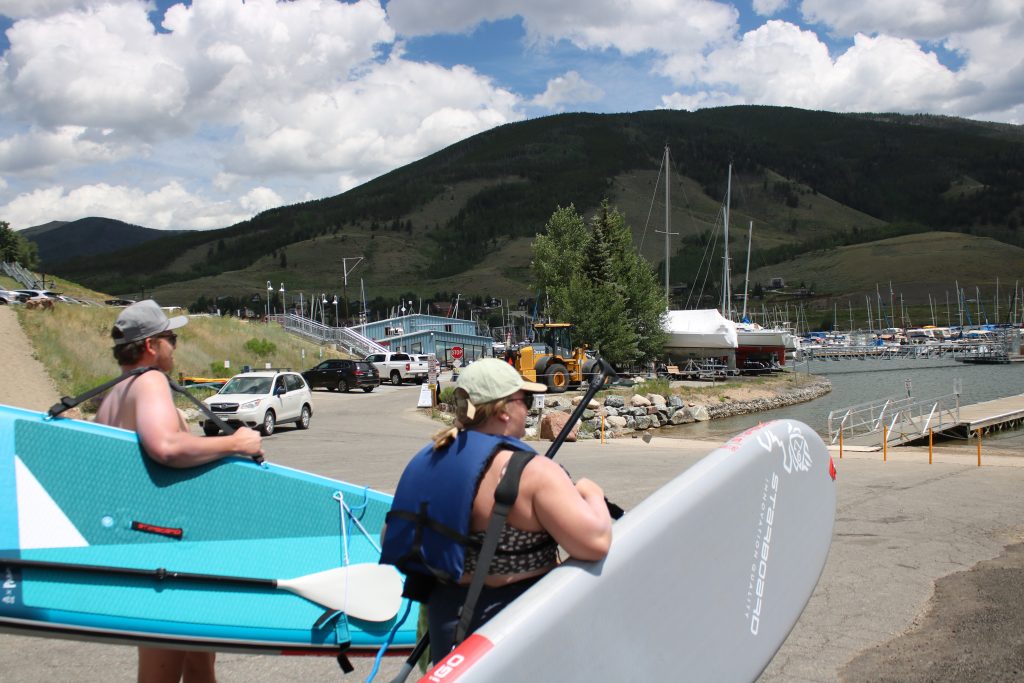The billboard project is expanding to Oregon
Amid climate change, Colorado’s mountain towns are warming with the rest of the planet, but high elevations provide some refuge
Ryan Spencer
Summit Daily News

Carleigh Bernard prepares to launch her paddleboard in the Dillon Reservoir on Tuesday, July 25, after traveling from Denver for a concert. Ryan Spencer/Summit Daily News
As the wind picked up into the early afternoon Tuesday, July 25, Jessica Olbricht and her family packed up the paddleboards, fishing rods and lawn chairs they had sprawled along the edge of the Dillon Reservoir.
The family had spent the morning at the Snake River Inlet, lounging in the sun as the two kids played out on the water until the cool mountain breeze turned gustier, making it difficult to paddle.
“Temperature-wise, it’s awesome,” Olbricht said. “We could do without the heat.”
Residents of Broomfield, the Olbricht family left the Denver-metro area Saturday for a weeklong vacation at their house in Breckenridge. While the city sweltered with 98-degree highs on Tuesday, Olbricht said her family has been hiking, biking and “taking advantage of the outdoors” in the cooler temperatures Summit County has to offer.
Meanwhile, across the water at the Dillon Marina, Carleigh Bernard and Clayton Faber had also made the trek from Denver, finding fairer weather in the mountains. A therapist and an investment adviser, respectively, the two had come to see the Noah Kahn show at the Dillon Amphitheater later that evening and decided to paddleboard in the meantime.

“It’s been rainy and sad, and then very hot,” Bernard said of Denver. “So this is freaking beautiful.”
After a particularly cool and rainy spring, Colorado is experiencing the first extended stretch of above-average temperatures of the summer season, according to National Weather Service forecaster Ayesha Wilkinson.
As the heatwave, which has roasted much of the U.S. for weeks, expands its reach into the Rocky Mountains, Wilkinson said the region’s high elevation has helped keep temperatures cooler than elsewhere in the state and many other parts of the country.
“Denver is at a lower elevation and across the plains, but if you increase your elevation you get decreasing temperatures just because the air molecules are spread out,” Wilkinson said. “They’re expanding further apart, so you get your pressure decreasing and so you get cooler temperatures.”
While mountain towns may not be sweltering like lower-elevation areas such as Denver and Boulder, that doesn’t mean they have escaped the above-average temperatures witnessed worldwide. This year already saw the hottest June on record, according to the World Meteorological Organization, and the beginning of July was the hottest week on record for the planet as a whole.
While the high in Denver on Tuesday was projected to be 98 degrees, just 1 degree below the 99-degree record set in 1963, temperatures have also been above normal, albeit cooler, throughout the mountains, Wilkinson said.
For example, the high temperatures projected Tuesday at the weather station in Park County, while not near the 88-degree record set in 2003, were expected to be 4 degrees above the normal 75 degrees, according to the National Weather Service. That is one of the few weather stations in the mountains with long-term data, she said. Preliminary data for Dillon, which has temperature data dating back to 1910, shows that the town was 1 degree short of the record of 86 degrees set in 1931.
Hotter days are becoming more common in Colorado and throughout the country as carbon pollution causes the atmosphere to trap more heat. This heatwave is no exception, according to Climate Central, a nonprofit of climate scientists and communicators.
The heat witnessed Tuesday from Glenwood Springs to Fort Collins, Denver and as far south as Colorado Springs, was made at least four times more likely due to climate change, according to Climate Central.
And the fingerprints of climate change are also all over the heatwave that has baked much of the southwest, including New Mexico, northern Texas and southern California this month, said Climate Central director of communications Peter Girard.
“You’re seeing this extreme region of climate-influenced temperature,” Girard said. “And of course it’s summer, so most of the areas you’re looking at temperatures are experientially high, so people can tell it’s hot.”
While it is impossible to specifically say whether human-caused climate change made Tuesday hotter than it would have been, scientists can calculate how much more likely hot days like Tuesday are becoming due to the warming atmosphere, Girard explained. That’s what Climate Central’s Climate Shift Index does by comparing climate models of the planet without climate change to real-world forecasts and observations, he said.
“You cannot say a given day it’s 90 but it would have been 85 if it weren’t for climate change, but we can say 90 degrees now happens 10% of the time, and it used to happen almost never,” Girard said. “And clearly the likelihood of the temperature reaching this temperature on this day is far more likely that it would have been without climate change.”
Most of Colorado and large swathes of the southwest reached level 4 of 5, or “extreme,” on the Climate Shift Index on Tuesday, meaning climate change made the balmy conditions at least 4 times more likely to occur.
As the climate warms, the cooling elevation of the Rocky Mountains is providing those who visit from warmer climes reprieve from the heat, even as temperatures tick up here too. As Bernard prepared to push her paddleboard into the Dillon Reservoir, she took in cool mountain air, adding, “This is ideal.”
This story is published via AP StoryShare.
External
Identification not yet made
UTTC International Powwow attendees share their rules for a fun and considerate event
Radio collaboration highlights importance of cooperation in a season of funding cuts for local media
A memorial in the Snow County Prison, now the United Tribes Technical College campus
Standing Rock Sioux Tribal Chairwoman Janet Alkire tells crowd, ‘We’re going to rely on each other’






